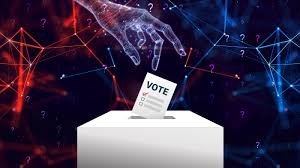Introduction
Artificial Intelligence (AI) is transforming industries worldwide, and elections are no exception. From voter data analysis to fraud detection and campaign management, AI is reshaping how elections are conducted, making them more efficient, transparent, and data-driven. In this blog, we’ll explore how AI is playing a crucial role in elections, its benefits, real-world case studies, and the challenges it presents.

The Role of AI in Elections
1. AI-Powered Voter Data Analysis
Elections involve vast amounts of voter data, and AI helps process, analyze, and interpret this information effectively. AI-driven tools assist in:
- Predicting voter behavior based on demographics and past voting patterns.
- Identifying key swing voters who could influence election outcomes.
- Analyzing social media sentiment to gauge public opinion.
Case Study: AI in the U.S. Presidential Election
In the U.S. elections, both political parties used AI-powered analytics to analyze voter behavior and tailor their campaign messages. AI helped determine which states and demographics to target, increasing voter engagement and turnout.
2. AI for Political Campaigns & Digital Advertising
Political campaigns now heavily rely on AI-driven data analytics for:
- Targeted digital marketing: AI helps create personalized political ads based on voters’ interests and preferences.
- Chatbots & virtual assistants: AI-powered bots engage with voters, answer queries, and encourage participation.
- Predictive analytics: AI forecasts which messages and campaign strategies will resonate most with the public.
Example: AI Chatbots in Indian Elections
During India’s General Elections, AI-powered chatbots helped political parties reach millions of voters via WhatsApp and Facebook Messenger, answering queries and providing real-time campaign updates.
3. AI in Election Security & Fraud Prevention
AI enhances election security by detecting and preventing fraud:
- Fake news detection: AI identifies misinformation and deepfake content spread to manipulate voters.
- Voter authentication: AI-based biometric recognition systems help in verifying voter identities.
- Cybersecurity: AI protects online voting systems from cyberattacks and hacking attempts.
Case Study: Deepfake Detection in European Elections
In the European Parliament elections, AI-based tools were deployed to detect and remove deepfake videos and fake political ads that spread misinformation about candidates. This helped ensure a fair and transparent election process.
4. AI for Real-Time Election Monitoring
AI-powered surveillance and monitoring systems ensure fair elections by:
- Tracking election irregularities like vote rigging and ballot tampering.
- Detecting voting anomalies that could indicate fraudulent activities.
- Analyzing media coverage to detect biases and misinformation campaigns.
Example: AI in Nigeria’s Elections
AI-powered election monitoring tools were used to analyze social media conversations and news coverage during Nigeria’s elections. These tools detected fake election results and misinformation campaigns, helping voters access accurate information.
5. AI in Vote Counting & Results Prediction
AI accelerates vote counting and result prediction with:
- Automated ballot counting using AI-powered image recognition.
- Early election trend forecasting by analyzing polling data.
- Reducing human errors in vote tabulation for more accurate results.
Case Study: AI-Based Vote Counting in Estonia
Estonia, known for its advanced e-voting system, uses AI to help verify digital votes, ensuring accuracy and security in election results. AI also assists in real-time trend analysis, predicting winners based on early voting data.
More Examples of AI Transforming Elections
6. AI-Powered Robo-Callers & Speech Analysis
AI-powered robo-callers and voice assistants deliver personalized campaign messages to voters, providing information about candidates and policies.
- Example: In the U.S. elections, AI was used to conduct voice-based polling and analyze voter sentiment based on phone interactions.
7. AI in Electoral Roll Management
AI helps update and manage voter lists by:
- Detecting duplicate or ineligible voters.
- Preventing voter suppression or errors in voter registration.
- Example: In Brazil, AI is used to cross-check voter databases and prevent fraudulent registrations.
8. AI in Predicting Election Outcomes
AI models analyze historical and real-time election data to predict voting trends and potential winners.
- Example: In France’s elections, AI-driven data analytics helped media channels make early projections about the likely election results with high accuracy.
Challenges of AI in Elections
While AI enhances election processes, it also presents challenges:
- Ethical concerns: The use of AI in elections raises privacy issues regarding voter data.
- AI bias & misinformation: AI algorithms can reflect biases, affecting fair election outcomes.
- Cybersecurity risks: AI-powered election systems are vulnerable to hacking and manipulation.
The Future of AI in Elections
As AI technology advances, we can expect:
- More secure online voting systems with AI-driven authentication.
- Advanced deepfake detection tools to combat fake political content.
- Hyper-personalized political engagement through AI-powered campaigns.
Conclusion
AI is transforming elections by making them more efficient, secure, and data-driven. From predicting voter behavior to enhancing election security, AI plays a vital role in modern democracy. However, ethical concerns and cybersecurity risks must be addressed to ensure AI is used responsibly in elections.
Call to Action
What are your thoughts on AI’s role in elections? Should it be regulated? Share your opinions in the comments below! 🗳️🤖


